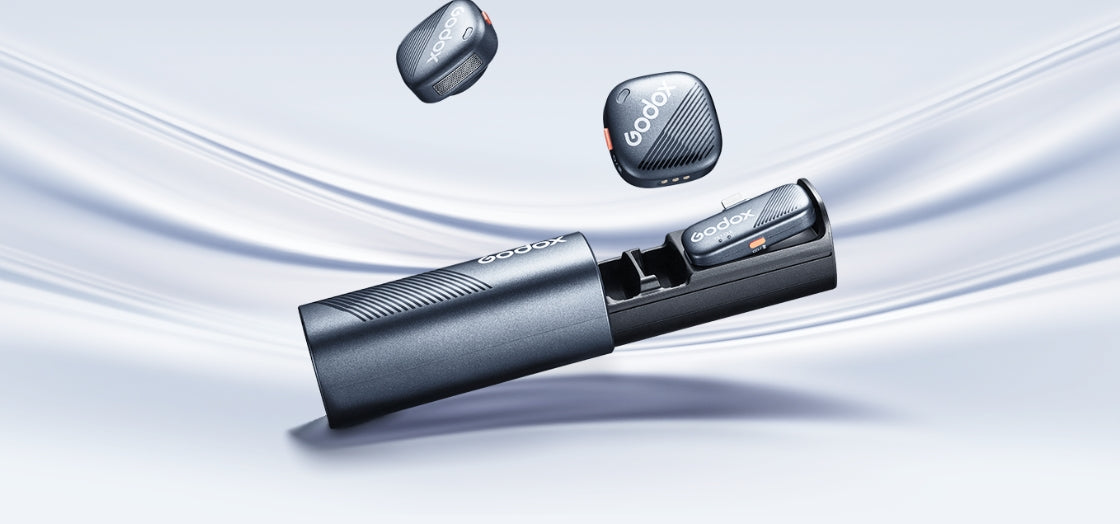Godox's Cube S microphone presents features that Hollyland Lark M2 and DJI Mic 2 lack.
The Hollyland Lark M2 and DJI Mic 2 now face a new competitor: the Godox Cube S microphone. Announced recently, the Godox Cube S microphone series (including Type-C and Lightning versions) is available for preorder starting this week.
This new microphone boasts a 7g size with 48kHz/24bit audio quality, a 300m stable transmission range, 30 hours of battery life, and flexible plug-and-play capability. Notably, it also supports Apple Find My, making it the first 2.4GHz wireless microphone system with this feature.
Before deciding to purchase the Godox Cube S microphone, you may want to compare it with the Hollyland and DJI microphones. While all three models offer impressive specs, there are key differences to consider.
One significant advantage of the Godox Cube S microphone is its Apple Find My support, which helps users track their microphones and avoid losing them. However, this feature is only available for iPhone users. In terms of pricing, the DJI Mic 2 is priced at $349, and the Hollyland Lark M2 starts around $125. Based on the price of its previous model, the Godox Cube S microphone may be cheaper than both.
Images in a Row


These differences are just the surface-level distinctions. A closer look at their displays, designs, and noise reduction capabilities reveals further contrasts. To help you decide between these options, we’ve compared some of their key features.
At first glance, the differences between the Hollyland Lark M2 and Godox Cube S microphones may seem minor. Both are compact, roughly the size of a coin, which makes them easy to use and conceal during recording. The DJI Mic 2, while slightly larger, includes features like internal recording that many users appreciate. However, for many vloggers and content creators, the compact size of the Cube S and Lark M2 microphones is advantageous for hiding during shoots.
Microphone adjustment is another area where the DJI Mic 2 and Hollyland Lark M2 differ. The Godox Cube S microphone features a single button on the transmitter that allows for toggling noise reduction or wirelessly starting/stopping recording on the receiver from up to 164 feet away with a double-click.
Both the Godox Cube S and Hollyland Lark M2 lack display screens and rely on button presses for adjustments. The Godox App, however, allows you to adjust settings such as real-time monitoring, volume control, dual-mode DNR, and instant speaker playback.
For more information on adjusting the Hollyland Lark M2 with its app, please refer to its video. In contrast, the DJI Mic 2 features an excellent display screen, which allows users to customize their settings more easily.
When it comes to same rate, these three wireless microphones come with 48 kHz / 24-Bit, allowing for higher accuracy in capturing audio frequencies, resulting in better sound quality and more detail compared to lower sample rates like 44.1 kHz.
It is also important to note that the maximum operating range is an essential feature during use. In our last article, we reviewed the Godox Magic XT1, which offers a 200m wireless range. The Godox Cube S has a maximum operating range of 984.3 feet, which is slightly shorter than the Hollyland Lark M2 but longer than the DJI Mic 2.
Lastly, we can compare these three microphones based on their battery life. According to official specifications, the Godox Cube S offers around 30 hours of usage with the extra charging case, while the Hollyland Lark M2 provides up to 40 hours and the DJI Mic 2 offers 18 hours.
Godox Magic XT1:
By the numbers
That’s just an overview of some of the main differences between the Godox Cube S microphone, Hollyland Lark M2 and DJI Mic 2 wireless microphone. If you want to explore compatibility, recording distance, and all of the raw specs in more detail, we’ve gathered them in the chart below.
Godox Cube S vs. Hollyland Lark M2 vs. DJI Mic 2
| Specification | Godox Cube S | Hollyland Lark M2 | DJI Mic 2 |
| Max Operating Range | 984.3' / 300 m (Line of Sight) | 1000' / 304.8 m | 820.2' / 250 m (Line of Sight) |
| Polar Pattern | Omnidirectional | Omnidirectional | Omnidirectional |
| Built-In Recorder | No | No | Yes |
| Sample Rate/Resolution | 48 kHz / 24-Bit | 48 kHz / 24-bit | 48 kHz / 24-Bit |
| Dynamic Range | 86 dB | 98-106 dB | 96.3dB |
| SNR | 75 dB | 70dB | 120 dB |
| Transmitter Type | Clip-On with Microphone | Clip-On with Microphone | Built-In (Transmitter) |
| Frequency Range | 20 Hz to 20 kHz | 20 Hz–20 kHz. | 50 Hz to 20 kHz |
| Maximum SPL | 115 dB SPL | 115 dB SPL | 120 dB SPL |
| Additional Runtime with Charging Case | 30 Hours | 40 hours | up to 18 h |
| Recharge Time | 2 Hours | 1.5 Hours | 1 hour and 10 minutes |

